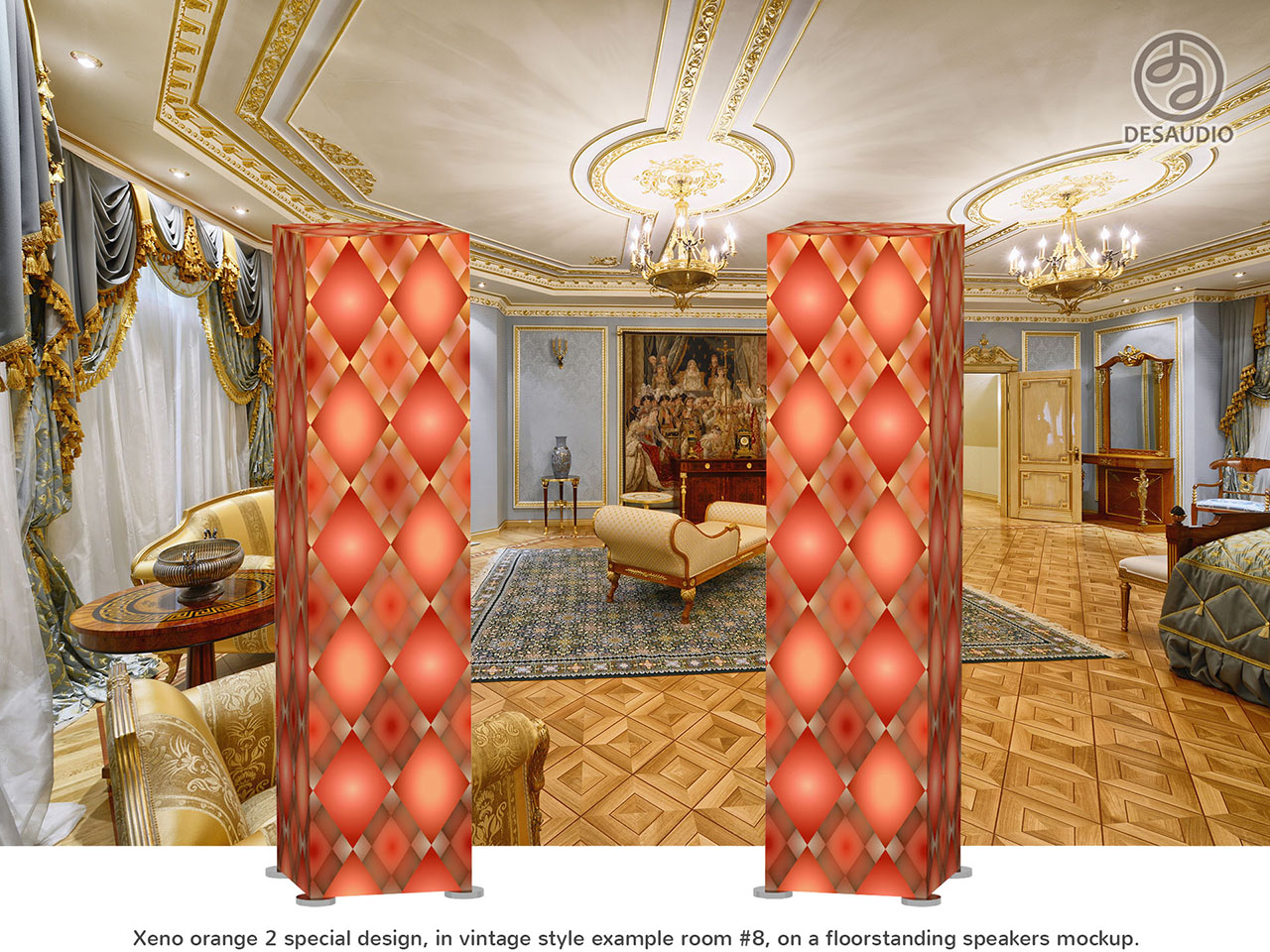Along with all the designs, 3D renderings, videos and augmented reality models that are presented here on the website of Desaudio, and the text of the book Designer Hi-Fi and Home Cinema Speakers and Devices, there are many other ideas for what the future might hold.
There is a lot more to come!
Here is a brief overview of six additional things that are on the informal future plan:
Celebrity Collab Designs
Another future idea is to team up with well known celebrities with great style sense, and create collaborations with them. These could be celebrities from the world of music and DJ’ing, from fashion, art, design and architecture, sports or films, as an example. The collaboration would be linked to the celebrity’s name and offered in limited drops, and could be realized on speakers, both living room and portable speakers, and perhaps other types of products as well, just like the ready Desaudio patterns that are available. The creations of colored patterns could be recorded in screencast videos like the ones Sverrir makes, or even in live streaming.
We could call this Celebrity Designer Home Audio, and can in fact be defined as a new product category, or design tendency, that has not been seen before, in itself.
This is an idea that will be further developed and hopefully introduced at an unknown later date. Remember this idea, and remember it was first introduced here on Desaudio’s website.
Home Audio Device Consultation and Sales
The goal is to be able to offer, as soon as possible, consultation and direct sales of loudspeakers and home audio/home cinema components. Thus, Desaudio would not just create and offer looks for loudspeakers and audio devices, (and later on components, see below), for those who already own or are acquiring loudspeakers of the kind where creating these covers makes sense. Desaudio would offer the entire package.
This of course makes sense, since those who are very sensitive about the decorative effect of the objects they place into their homes, and how they harmonize aesthetically with other objects in the room, are less likely to have acquired high-performance audio devices, as is discussed above. So they are not a direct market for Desaudio in that sense, since they don’t own any equipment that covers with Desaudio designs could be created for.
The consultation and sales service would focus on learning about the situation of the client, i.e. what the intended use is (music, and/or TV sound), the size and characteristics of the room, the qualities of the room and furniture/furnishings with regard to sound reflection of surfaces (is it a lively space or dampened space, calling for a warm or bright speaker, respectively), to be able to offer the best solution in terms of speaker character and speaker size (meaning speaker driver (diaphragm) size so as to not overwhelm the room with too much low frequency sound energy), source and amplification technology, active or passive speakers, placement issues and possible acoustical room correction solutions, and so forth.
Acoustical Room Treatments
The page about acoustical excellence (see here) lists the factors that influence the acoustical listening quality. Out of the five factors (of which the fifth factor is the aesthetics of the equipment which may fill somebody with disbelief at first), three of the factors are about the room which the speakers and listener(s) is located in, and not the audio devices themselves. The fact is, that when you listen to music from loudspeakers, 50-70% of what you hear may come from the room via surface reflections, while only 30-50% of what you hear comes directly from the speakers.
A future plan is to be able to offer consultation and solutions in acoustical room treatments, that have the purpose of improving the acoustical characteristics of the room, and thus improve the listening experience. An aspect of this would, of course, be the aesthetic design and color hues of these treatments, so that they harmonize with the overall style of the room, just like the designs of the loudspeakers presented on this website. But of course, as much as the main purpose of a speaker is to generate a sound and not just to be good looking, then the main purpose of the acoustical room treatments are to work with the acoustical problems that arise in a situation, that have to do with treating room modes and standing waves (escalation and dip), comb filtering, and low frequency problems (booming issues).
The treatments and solutions are mainly of these four types:
- Sound absorbers.
- Sound diffusers.
- Sound reflection/redirection.
- Low frequency treatments like tube traps and tri traps.
Acoustical room treatments have mainly been implemented in recording studio mixer rooms, and dedicated listening rooms. The focus here would be not less on ways to improve the acoustical situation in “ordinary homes”, where we have multi-purpose rooms, where the listening experience is not the only preference, but a part of a larger set of preferences that may interact in complex ways. The goal is to find and recommend solutions that have the effect of improving the acoustical quality, while not interfering negatively with other preferred uses of the room, and is thus a balancing act.
Looks for audio components as well
The future plan is to develop solutions to be able to offer aesthetic designs for the audio components to be more colorful and creative, and a better match with different interior design styles and with the other items in the particular room where the components are placed. The technology to do this is available and known by the founder of Desaudio, and relatively straight forward.
While loudspeaker covers can, technically, be made by Desaudio entirely independently, then offering new looks for audio components would at best be done in close collaboration with a components manufacturer.
It is unknown when this may be available. More will be revealed in due time, but at the present moment, no time estimates can be given.
Here are a few informal ideas about how these might look.
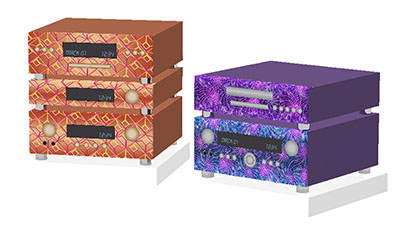
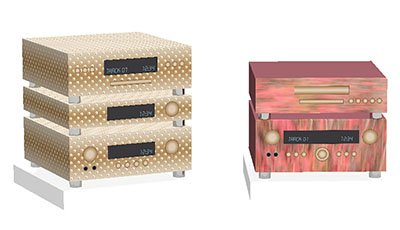
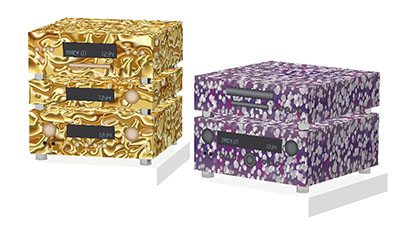
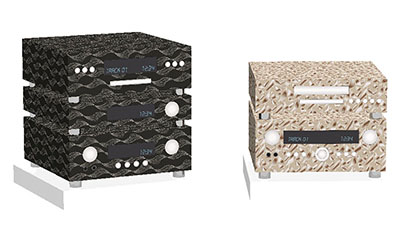
Non-fungible tokens
It is being considered to offer, if requested, to deliver a numbered, limited edition color version, or custom coloring, or bespoke creation, as a non-fungible token, or NFT.
The added benefits and digital items that come with it would be added to the NFT as collector’s rewards. Those can only be viewed by the owner of the NFT.
NFTs can be easily sold, so this is an option who would like to have the option of selling the Desaudio design on the secondary market, and possibly enjoy a positive price development because of collector’s value. (It is not possible to give any prediction about the secondary market price development of limited edition Desaudio color versions, or custom colorings or bespoke creations). The option would be to have them listed on OpenSea or Rarible.
The rights to have the pattern realized on loudspeaker covers (or audio device front plates), or some other types of printed products that are made available specially for that, will be linked to the digital certificate of the NFT, and can only be realized by the owner of the NFT.
The NFT could be minted on the Ethereum blockchain (which will require additional gas fees), or on the Polygon layer of the Ethereum blockchain which has a lower carbon footprint and will cost less, but is considered slightly less stable and secure than the Ethereum blockchain itself.
Expos and trade shows, and trade association
It would be interesting when time passes and new brands with their own distinct styles and design language enter this space, to have an expo or trade show, where those brands could showcase their creations.
This could be a fun venue to come together, see what is being offered in this new space, and to mingle and discuss.
It could be an idea also to establish a trade association around the issues of designer home audio especially.
Other market segments have their own well-known expos and trade shows, and it could be a good idea to have a section, several booths perhaps, for designer home audio or high-end audio:
In high-end audio, well known trade fairs are High End Munich, in Munich, Germany, AXPONA (Audio Expo North America) in Schaumburg, Illinois, the Bristol Hi-Fi Show in Bristol, UK. Then there are others perhaps smaller ones, like T.H.E. Show in Long Beach, California, the Salon Audio Montreal Audio Fest in Montréal, Canada, the AudioConLA in Los Angeles, California, and many others. Then there is the big, general consumer electronics focused show, the CES, which is an annual trade show organized by the Consumer Technology Association, in Winchester, Nevada, U.S.
In furniture and furnishings, well known exhibitions and fairs include the Salone del Mobile in Milan, Italy, Paris Design Week in Paris, France, the Highpoint Market in London, UK, the Stockholm Furniture & Light Fair in Sweden, and in the United States the ICFF in New York, the NeoCon in Chicago, and the HD Expo + Conference in Las Vegas, just to name a few.
In watches and jewelry, we know HourUniverse (formerly Baselworld) in Basel, Switzerland, and Watches & Wonders (SIHH) in Geneva, Switzerland, as well as Watches & Wonders in Miami, Florida. We also know Hong Kong Watch & Clock Fair in Hong Kong, the Dubai Watch Week, Midora in Germany, Masters of LXRY in Amsterdam, and Bijorhca in Paris, France.
In the field of fashion, we of course know the fashion weeks, in Paris, Milan, London, New York, and in many other cosmopolitan cities.
So maybe one day we will enjoy an expo or trade fair celebrating the many different facets of interior design-focused home audio loudspeakers and devices designs? That would be truly interesting.
